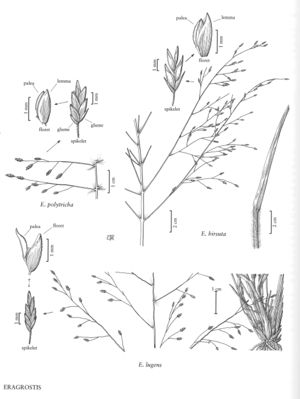Difference between revisions of "Eragrostis hirsuta"
FNA>Volume Importer |
FNA>Volume Importer |
||
| Line 7: | Line 7: | ||
|synonyms={{Treatment/ID/Synonym | |synonyms={{Treatment/ID/Synonym | ||
|name=Eragrostis hirsuta var. laevivaginata | |name=Eragrostis hirsuta var. laevivaginata | ||
| − | |authority= | + | |authority= |
| + | |rank=variety | ||
}} | }} | ||
|hierarchy=Poaceae;Poaceae subfam. Chloridoideae;Poaceae tribe Cynodonteae;Eragrostis;Eragrostis hirsuta | |hierarchy=Poaceae;Poaceae subfam. Chloridoideae;Poaceae tribe Cynodonteae;Eragrostis;Eragrostis hirsuta | ||
| Line 20: | Line 21: | ||
-->{{Treatment/Body | -->{{Treatment/Body | ||
|distribution=Md.;N.J.;Mass.;Miss.;Tex.;La.;W.Va.;Mo.;Del.;Ala.;Tenn.;N.C.;S.C.;Va.;Ark.;Ill.;Ga.;Okla.;Ky.;Fla.;Ohio | |distribution=Md.;N.J.;Mass.;Miss.;Tex.;La.;W.Va.;Mo.;Del.;Ala.;Tenn.;N.C.;S.C.;Va.;Ark.;Ill.;Ga.;Okla.;Ky.;Fla.;Ohio | ||
| − | |discussion=<p>Eragrostis hirsuta grows in sandy clay loams on the coastal plain and along roadsides, at 0-150 m, usually in association with Pinus palustris and Quercus. Its range extends from the southeastern United States through eastern Mexico to Guatemala and Belize.</p> | + | |discussion=<p><i>Eragrostis hirsuta</i> grows in sandy clay loams on the coastal plain and along roadsides, at 0-150 m, usually in association with <i>Pinus palustris</i> and <i>Quercus</i>. Its range extends from the southeastern United States through eastern Mexico to Guatemala and Belize.</p> |
|tables= | |tables= | ||
|references= | |references= | ||
| Line 29: | Line 30: | ||
-->{{#Taxon: | -->{{#Taxon: | ||
name=Eragrostis hirsuta | name=Eragrostis hirsuta | ||
| − | |||
|authority=(Michx.) Nees | |authority=(Michx.) Nees | ||
|rank=species | |rank=species | ||
| Line 36: | Line 36: | ||
|basionyms= | |basionyms= | ||
|family=Poaceae | |family=Poaceae | ||
| − | |illustrator=Linda A. Vorobik | + | |illustrator=Linda A. Vorobik;Cindy Roché |
| + | |illustration copyright=Utah State University | ||
|distribution=Md.;N.J.;Mass.;Miss.;Tex.;La.;W.Va.;Mo.;Del.;Ala.;Tenn.;N.C.;S.C.;Va.;Ark.;Ill.;Ga.;Okla.;Ky.;Fla.;Ohio | |distribution=Md.;N.J.;Mass.;Miss.;Tex.;La.;W.Va.;Mo.;Del.;Ala.;Tenn.;N.C.;S.C.;Va.;Ark.;Ill.;Ga.;Okla.;Ky.;Fla.;Ohio | ||
|reference=None | |reference=None | ||
| Line 42: | Line 43: | ||
|publication year= | |publication year= | ||
|special status= | |special status= | ||
| − | |source xml=https:// | + | |source xml=https://jpend@bitbucket.org/aafc-mbb/fna-data-curation.git/src/f50eec43f223ca0e34566be0b046453a0960e173/coarse_grained_fna_xml/V25/V25_154.xml |
|subfamily=Poaceae subfam. Chloridoideae | |subfamily=Poaceae subfam. Chloridoideae | ||
|tribe=Poaceae tribe Cynodonteae | |tribe=Poaceae tribe Cynodonteae | ||
Revision as of 21:34, 16 December 2019
Plants perennial; cespitose, with innovations and hardened bases, without rhizomes, not glandular. Culms (30)45-100 cm, erect, glabrous below the nodes. Sheaths rarely glabrous, apices and distal margins usually hairy, sometimes also densely hairy basally, dorsally, and on the collars, hairs to 6 mm, papillose-based; ligules 0.2-0.4 mm; blades 25-60 cm long, 3-8(11) mm wide, flat to loosely involute, usually glabrous, adaxial surfaces sometimes hairy basally. Panicles 25-85 cm long, 15-40 cm wide, broadly ovate, open; primary branches mostly 4-35(45) cm, diverging 20-90° from the rachises, capillary; pulvini glabrous or hairy; pedicels 2-28 mm, divergent. Spikelets 2-4(5) mm long, 1-1.7 mm wide, lanceolate, greenish with purplish tinges, with 2-6 florets; disarticulation acropetal, paleas persistent. Glumes lanceolate, hyaline to membranous; lower glumes 1.1-2 mm; upper glumes 1.5-2.8 mm, apices acuminate to acute; lemmas 1.6-2.4 mm, ovate, membranous, hyaline near the margins, lateral veins inconspicuous, apices acute; paleas 1.2-2.2 mm, hyaline, bases not projecting beyond the lemmas, apices acute to obtuse; anthers 3, 0.3-0.8 mm, purplish. Caryopses 0.8-1 mm, rectangular-prismatic, somewhat laterally compressed, with or without a well-developed adaxial groove, striate, opaque, reddish-brown. 2n = 100.
Distribution
Md., N.J., Mass., Miss., Tex., La., W.Va., Mo., Del., Ala., Tenn., N.C., S.C., Va., Ark., Ill., Ga., Okla., Ky., Fla., Ohio
Discussion
Eragrostis hirsuta grows in sandy clay loams on the coastal plain and along roadsides, at 0-150 m, usually in association with Pinus palustris and Quercus. Its range extends from the southeastern United States through eastern Mexico to Guatemala and Belize.
Selected References
None.
